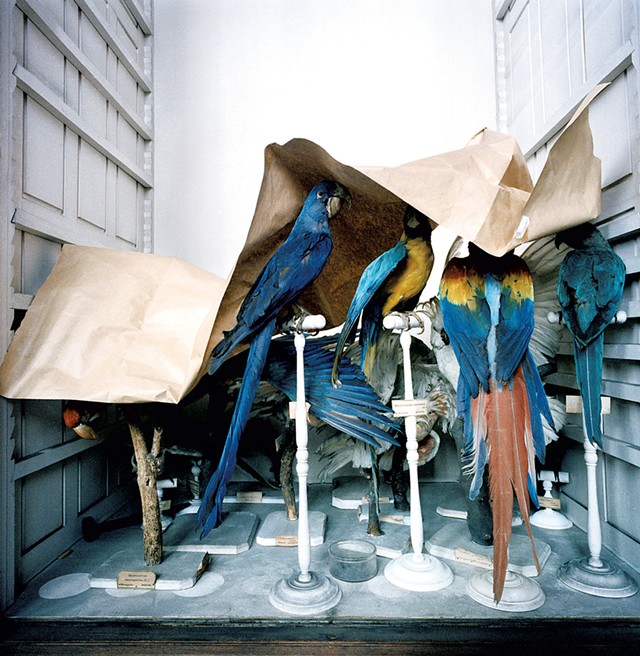
- Courtesy Of The Artist
- "Museum National d'Histoire Naturelle, Paris, France, 1982" from "Museology" by Richard Ross
Museums of the so-called Western world are currently engaged in a moment of reckoning. Instead of simply focusing on how rare, unique or masterfully made the objects in their collections are, curators are questioning how those objects arrived at the museums in the first place. Often, their acquisition was made possible by colonialism.
Contemporary artists are also becoming interested in the intersection of museum practices and colonialist enterprises. In Burlington, the University of Vermont's Fleming Museum of Art is currently hosting a traveling exhibition that gathers mainly conceptual pieces on this topic by 17 artists from around the world. "Never Spoken Again: Rogue Stories of Science and Collections" was produced by Independent Curators International, a Manhattan-based institute that supports emerging avant-garde curators. David Ayala-Alfonso, a Colombian national who lives in Mexico City, curated the show.
Ayala-Alfonso frames the exhibition with a fictitious story: An unnamed German scientist from an unidentified era — the introductory text leaves several blanks — produced a comprehensive study of new-world land and species that became a "milestone in the history of the conquest of the Americas."
Meanwhile, that same scientist spent 20 years secretly studying one bird's utterances. He finally determined that the bird was simply imitating bits of every language it had heard, but he nonetheless "forcibly edited the animal's random noises into the form of a language."
The framing asks visitors to imagine the fictional scholar's practice writ large: the "scientific" domination of colonized cultures through appropriation and classification. It engages visitors in that act by leaving parts of the story to their imagination. And it makes the point that the "rogue" stories explored in the exhibition cannot be assumed to be true.
As a Werner Herzog quote painted on one wall puts it, truth is created through "fabrication and imagination and stylization." (Fleming curator Kristan Hanson identified the quote for Seven Days; the exhibition has no attribution.)
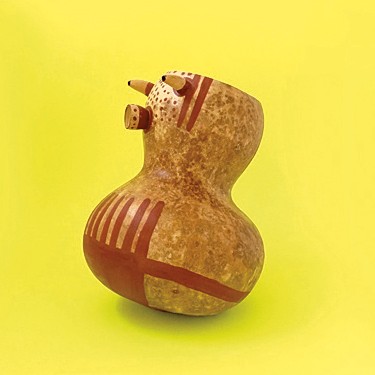
- Courtesy Of The Artist
- "Summon Song I" (detail) by Ulrik López
Mexican artist Ulrik López threads that needle of truth-as-creation carefully. His work "Summon Song I" (2018-19) positions replicas of gritones — pre-Hispanic ceramic vessels shaped like screaming heads that were used for long-distance communication — as caryatids supporting a large, disused stereo. Out of a hidden mini-stereo come sounds of a voice experimenting with gasps, howls, hums and breaths. A photo shows a fictitious excavation site where the vessels were supposedly discovered.
Lopez's work, most of which is displayed on a simple table, echoes a museum exhibit, but no glass separates these objects from visitors, and sound animates them. "Our hope is that visitors take the stories told in the exhibition [and bring them] into our permanent collections," Hanson said. There they might see with new eyes, for instance, the Fleming's own Mesoamerican display, which she described as "behind glass, frozen."
Glass is part of the critique of colonialism in Brazilian artist Maria Thereza Alves' "The Ways They Make War With Worlds" (1984/2020). Her work captures a moment in the 1980s that signaled a turn toward self-determination for the Indigenous peoples of the Brazilian Amazon. It includes long excerpts of the 1980 testimony that Alvaro Fernandez Sampaio Tukano, one of the Indigenous Tucano people, gave at a tribunal in Rotterdam, Netherlands. In it, he accused the Salesian missionaries, a Catholic order that had colonized the Amazon, of ethnocide.
Alternating with the transcripts are photographs Alves took in 1984 of exhibits in the Museu do Índio in Manaus, Brazil. The shots show life-size anthropological dioramas of Indigenous people behind glass and highly ordered displays of materials they used. Nothing about the images indicates an unmediated understanding of the people the museum purported to preserve.
Exposing colonial destruction is at the heart of some additional works, such as Colombian artist Reyes Santiago Rojas' "Sugar Crush No. 1," a wooden mule saddle on which the artist balances bundles of sugarcane-shaped rods made from contemporary soda cans.
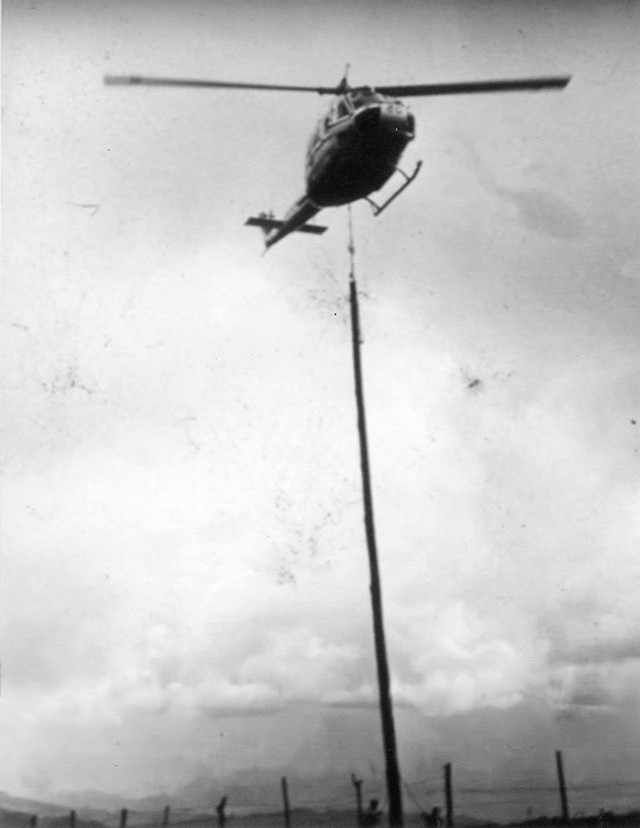
- Courtesy Of The Artist/Fleming Museum
- "Especies Verticales" by Sofia de Grenade
In the 2018 work "Especies Verticales (Vertical Species)," Chilean artist Sofia de Grenade addresses colonialism through eucalyptus, a plant that outside corporations brought to South America from Australia in the 1850s for uses such as producing power poles. The invasive plant now covers South America and has transformed its natural landscapes, according to the label. In de Grenade's installation, the vertical elements of what appears to be an irrigation device echo the electricity pole dangling from a helicopter in a found photo from a Colombian wood-treatment facility.
Not all the artists' works are gulp-inducing; some are genuinely funny. American artist Daniel R. Small's "Excavation II" (2016) combines "artifacts" preserved under glass from the destroyed set of Cecil B. DeMille's 1923 film The Ten Commandments with paintings cut from their frames that formerly adorned the Luxor hotel and casino in Las Vegas — named for the Luxor Temple in Egypt.
The Egypt collectively depicted by these objects is a pastiche of fantasy and fact. The label for "Sphinx Chest Ornamentation," for example, points out that the plaster movie-set fragment is riddled with bullet holes, just as the real Sphinx in Giza bears bullet holes inflicted by British soldiers during World War II. The fragments' "history" is made to appear timelessly preserved through the trappings of the traditional museum display.
Just as humorous is Turkish artist Erkan Öznur's "Der Tempel dom Potsdamer Platz (The Temple From Potsdamer Platz)," from 2014. In three framed informational posters, a plaster model and a video, the work tells a fictional yet plausible story. A Turkish archaeologist discovers a pagan temple during a 1945 dig in the central Berlin public square of Potsdamer Platz. Under the pretext of using its monoliths for road construction, the scientist and his team excavate the temple and ship it back to Turkey, where it's discovered in a museum archive and reconstructed.
"The German authorities are still running a worldwide campaign to bring the temple back to its place of origin," one poster reads.
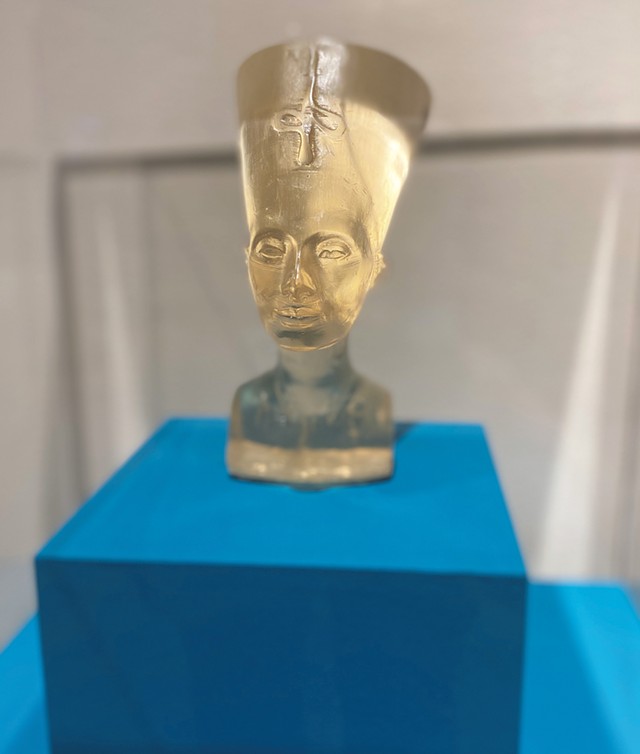
- Courtesy Of UVM Fablab
- Copy of the "Bust of Nefertiti" by the UVM FabLab
In a sense, Öznur's work depicts the geographical reverse of museum practices surrounding the Nefertiti bust — a copy of which, from the Fleming holdings, follows Small's faux-Egyptian "Excavation II." The real Nefertiti bust, from mid-14th-century BC Egypt, was excavated in 1912 by German archaeologists and smuggled out using a deliberately erroneous label. "Over the past century, Egyptian authorities have requested its return to no avail," a label reads.
The question of ownership continues. The Fleming's plaster copy was one of many made and sold in the 1920s by a Berlin fabrication company. Rights to the image and its reproduction eventually came to rest with the Berlin State Museum. When two Berlin artists hacked the museum's 3D scan of Nefertiti in 2015 and made it public, they were violating the museum's ownership of the image — and making the point that such colonial notions of ownership were outdated.
That forced the museum to make the 3D scan available for free, with attribution, through Creative Commons. In 2023, students at the UVM FabLab used that technology to produce a 3D-printed miniature of the bust in resin, which appears in this show beside the plaster copy. Its label announces all the relevant attributions, as it legally must — but leaves hanging the implication that Egypt is the true owner.
Ayala-Alfonso's introduction describes "Never Spoken Again" as a collection of "stories of fabrication, chance and deceit" — stories that ultimately question and even undermine museum curation. Does that bother Hanson, the Fleming's curator?
"I think it's very much needed," she said. "I think we're at a moment where we're focusing on how these objects entered our care and what our responsibilities are. It's a really exciting time for us but also a really challenging time."
Correction, April 8, 2024: An earlier version of this story misgendered Ulrik Lopez.
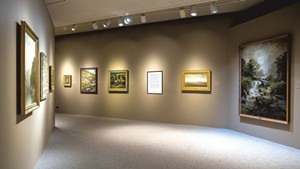








Comments
Comments are closed.
From 2014-2020, Seven Days allowed readers to comment on all stories posted on our website. While we've appreciated the suggestions and insights, right now Seven Days is prioritizing our core mission — producing high-quality, responsible local journalism — over moderating online debates between readers.
To criticize, correct or praise our reporting, please send us a letter to the editor or send us a tip. We’ll check it out and report the results.
Online comments may return when we have better tech tools for managing them. Thanks for reading.